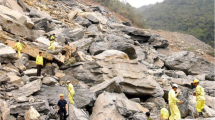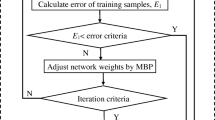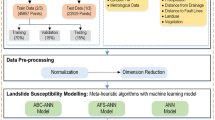Abstract
Mining subsidence prediction based on monitoring data is a vital task in engineering construction over underground mines. To improve the accuracy of predicting mining subsidence, a method based on the niching genetic algorithm (NGA) and the Holt–Winters model is proposed here. The NGA including niche selection methodology is chosen due to the defects of the genetic algorithm. The NGA is applied to optimize the parameters of the Holt–Winters model. The NGA–Holt–Winters model was applied to mining subsidence prediction on two sides of the Siping–Changchun expressway. The results show that the NGA enhances the convergence speed and precision of the algorithm, with both the convergence speed and forecast accuracy being superior to those of the grey model and the support vector machine model. The relative errors of the NGA–Holt–Winters model are less than 2% and the mean error is − 0.18%. The proposed model has better long-term prediction accuracy for mining subsidence than the support vector machine model, showing lower mean errors of between − 0.49 and − 0.79%.








Similar content being viewed by others
References
Brady BHG, Brown ET (2011) Rock Mechanics for Underground Mining, 3rd edn. Science Press, Beijing
Chen X, Su J, Li Y (2017) Application of a niching genetic algorithm to the optimization of a SiC crystal growth system. J Mater Sci Mater Electron 28:269
Chio JK, Kim KD, Lee S, Won JS (2010) Application of a fuzzy operator to susceptibility estimations of coal mine subsidence in Taebaek City, Korea. Environ Earth Sci 59:1009–1022
Fang YB (2007) Analysis and processing of settlement data based on time series analysis. Journal of Shandong University of Technology (Natural Science Edition) 21(5):32–35
Holt CC (1957) Forecasting trends and seasonals by exponentially weighted averages. Carnegie Institute of Technology, Pittsburgh
Isik Y (2010) Comparison of landslide susceptibility mapping methodologies for Koyulhisar, Turkey: conditional probability, logistic regression, artificial neural networks, and support vector machine. Environ Earth Sci 61:821–836
Kim KD, Lee S, Oh HJ (2009) Prediction of ground subsidence in Samcheok City, Korea using artificial neural networks and GIS. Environ Geol 58:61–70
Kim Y, Son M, Moon HK, Lee SA (2017) A study on the development of an artificial neural network model for the prediction of ground subsidence over abandoned mines in Korea. Geosystem Engineering 20(3):163–171
Lee S, Park I, Choi JK (2012) Spatial prediction of ground subsidence susceptibility using an artificial neural network. Environ Manag 49:347–358
Li PX, T ZH, Yan LL, Deng KZ (2010a) Calculation method of probability integration method parameters based on support vector machine. China Coal Soc 35(8):1247–1251 in Chinese
Li WX, Liu L, Dai LF (2010b) Fuzzy probability measures based non-symmetric membership function: engineering examples of ground subsidence due to underground mining. Eng Appl Artifi Int 23(3):420–431
Li YK, Tian YJ, Ouyang ZY, Wang LY, Xu TW, Yang PL, Zhao HX (2010c) Analysis of soil erosion characteristics in small watersheds with particle swarm optimization, support vector machine and artificial neuronal networks. Environ Earth Sci 60:1559–1568
Li L, Wu K, Zhou DW (2014) Extraction algorithm of mining subsidence information on water area based on support vector machine. Environ Earth Sci 72:3991–4000
Liu ZX, Liu C, Liu Q, Yue YL (2010) Chaotic time series reconstruction and security alarm system of rock mass deformation in undersea mining. Chinese Journal of Geotechnical Engineering 32(10):1530–1534
Loupasakis C, Angelitsa V, Rozos D, Spanou N (2014) Mining geohazards-land subsidence caused by the dewatering of opencast coal mines: the case study of the Amyntaio coal mine, Florina, Greece. Nat Hazards 70:675–691
Ma C, Cheng X, Yang Y, Zhang X, Guo Z, Zou Y (2016) Investigation on mining subsidence based on multi-temporal InSAR and time-series analysis of the small baseline subset—case study of working faces 22201-1/2 in Bu’ertai Mine, Shendong Coalfield, China. Remote Sens 8:951
Malinowska A (2011) A fuzzy inference-based approach for building damage risk assessment on mining terrains. Eng Struct 33:167–170
Martin D, Alcala-Fdez J, Rosete A, Herrera F (2016) NICGAR: A niching genetic algorithm to mine a diverse set of interesting quantitative association rules. Inf Sci 355–356:208–228
Nie L, Peng W, Yuan MZ, Zhou NJ (2011) Ground collapse prediction of mined-out area based on EMD and WLS-SVM. J Jilin Univ (Earth Sci Ed) 41(3):799–804
Nie L, Zhang M, Jian H (2013) Analysis of surface subsidence mechanism and regularity under the influence of seism and fault. Nat Hazards 66:773–780
Paraschiv D, Tudor C, Petrariu R (2015) The textile industry and sustainable development: a Holt–Winters forecasting investigation for the Eastern European area. Sustainability 7:1280–1291
Sareni B, Krahenbuhl L, Nicolas A (1997a) Niching genetic algorithms in optimization in electromagnetics I. Fundamentals. IEEE Trans Magn 34(5):2984–2987
Sareni B, Krahenbuhl L, Muller D (1997b) Niching genetic algorithms in optimization in electromagnetics II. Shape optimization of electrodes using the CSM. IEEE Trans Magn 34(5):2988–2991
Shi B, Li YX, Yu XH, Niu YL (2010) Long-term runoff forecast method based on dynamic adjustment particle swarm optimizer algorithm and holt-winters linear seasonal model. Transactions of the Chinese Society of Agricultural Engineering 26(7):8–13
Sudheer G, Suseelatha A (2015) Short term load forecasting using wavelet transform combined with Holt–Winters and weighted nearest neighbor models. Electr Power Energy Syst 64:340–346
Tomaz A, Goran T (2003) Prediction of subsidence due to underground mining by artificial neural networks. Comput Geosci 29:627–637
Wang Z (2000) Practical method for system prediction. Nationalities Press, Beijing, pp 125–126
Wang QR (2010) Combination forecast of railway freight volume based on Holt-Winter model and neural network. Journal of Lanzhou Jiaotong University 29(4):122–125
Wang ZS, Deng KZ (2012) Residual subsidence prediction of abandoned mine goaf based on wavelet support vector machines. Adv Mater Res 524-527:330–336
Will A, Bustos J, Bocco M (2013) On the use of niching genetic algorithms for variable selection in solar radiation estimation. Renew Energy 50:168–176
Winters PR (1960) Forecasting sales by exponentially weighted moving average. Manag Sci 6:324–342
Wu DH (2008) Dynamic exponential smoothing prediction method and its applications. J Syst Manag 17(2):151–155
Xia QQ, An PY, He YG, Wu SC (2010) Subsidence prediction of mining area based on the grey theory. Journal of Transport Science and Engineering 26(3):52–55
Xu H, Liu B, Fang Z (2014) New grey prediction model and its application in forecasting land subsidence incoal mine. Nat Hazards 71:1181–1194
Yang WF, Xia XH (2013) Prediction of mining subsidence under thin bedrocks and thick unconsolidated layers based on field measurement and artificial neural networks. Comput Geosci 52:199–203
Yin GZ, Zhang WZ, Zhang DM, Kang QR (2007) Forecasting of landslide displacement based on exponential smoothing and nonlinear regression analysis. Rock Soil Mech 28(8):1725–1728
Zhang L, Yan SF (2006) Comparison of Holt-Winters and ARIMA methods for forecasting charge of China Airline passengers. Journal of Shanghai University of Engineering Science 20(3):280–283
Zhu GY, Xu ZH, Xie C, Guo Y (2014) Study on influence functions of surface residual movement and deformation above old goaf (in Chinese). Chin J Rock Mech Eng 33(10):1962–1970
Acknowledgments
The authors thank the participants who contributed to this work.
Funding
This project was funded by the China Postdoctoral Science Foundation (Grant No. 20100471265).
Author information
Authors and Affiliations
Corresponding author
Additional information
Editorial handling: A. Karrech
Rights and permissions
About this article
Cite this article
Peng, S., Qin, S. & Li, G. Predicting expressway subsidence based on niching genetic algorithm and Holt–Winters model. Arab J Geosci 12, 354 (2019). https://doi.org/10.1007/s12517-019-4514-x
Received:
Accepted:
Published:
DOI: https://doi.org/10.1007/s12517-019-4514-x




